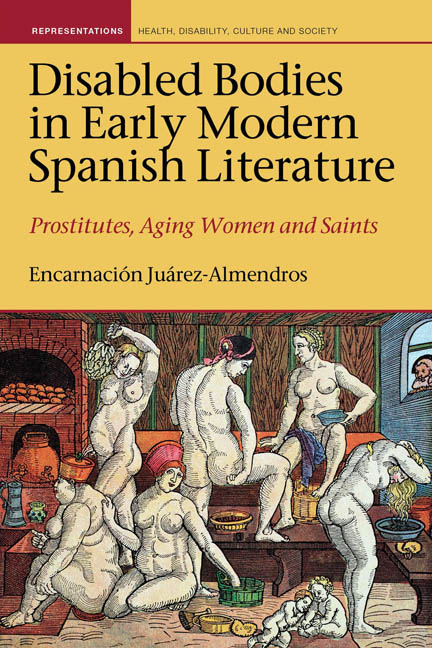Book contents
- Frontmatter
- Contents
- Acknowledgments
- Introduction
- I The Creation of Female Disability: Medical, Prescriptive and Moral Discourses
- II The Artifice of Syphilitic and Damaged Female Bodies in Literature
- III The Disabling of Aging Female Bodies: Midwives, Procuresses, Witches and the Monstrous Mother
- IV Historical Testimony of Female Disability: The Neurological Impairment of Teresa de Ávila
- Conclusion
- Works Cited
- Index
IV - Historical Testimony of Female Disability: The Neurological Impairment of Teresa de Ávila
- Frontmatter
- Contents
- Acknowledgments
- Introduction
- I The Creation of Female Disability: Medical, Prescriptive and Moral Discourses
- II The Artifice of Syphilitic and Damaged Female Bodies in Literature
- III The Disabling of Aging Female Bodies: Midwives, Procuresses, Witches and the Monstrous Mother
- IV Historical Testimony of Female Disability: The Neurological Impairment of Teresa de Ávila
- Conclusion
- Works Cited
- Index
Summary
The first chapter of this book discussed the construction of female disability in diverse medical and moral discourses that explained and propagated the idea of the inferiority of female embodiment and its vulnerability and propensity to immoral behavior. The second and third chapters assessed how male authors assumed and supported these conceptions in their representation of women as figures with imperfect and contaminated bodies connected with impurity and evil. Syphilis and decay become the central metaphoric conditions attached to these female protagonists, who were rejected because of their behavior and old age. Ultimately male writers project their own fear of disease and death onto the female characters. In contrast to the representational disabling of women, this chapter examines the first-person testimony of a chronically ill woman in Libro de la vida [The Book of Her Life], an autobiographical narrative by Teresa of Ávila, also known as Teresa of Jesús, baptized as Teresa Sánchez de Cepeda y Ahumada (Ávila 1515), who recent scholarship has suggested may have had the stigmatized disease of epilepsy. Teresa was a Carmelite nun who reported having divine visions and graces, dedicated her life to spiritual perfection and died in 1582 surrounded by an aura of sanctity at the peak of the Counter Reformation. She was beatified in 1614, canonized in 1622 and proclaimed a Doctor of the Church in 1970.
The leap from the analysis of literary prostitutes and aged witches to the examination of the life narrative of a saint may seem drastic but, in the conceptualization of the period, there was in fact a very thin line differentiating female witchcraft from religious ecstasy and demonic possession from mystical union (Mazzoni 11–12). All these states of being possessed underline female passivity and receptivity of an invasive Other. Nonetheless, and in contrast with the characters studied in previous chapters, Teresa's case demonstrates how an individual historical figure with the power of expression was able to transform passivity into agency and an impairment that provoked persecution into a positive asset. Through the methodology of the cultural disability model I argue that Teresa locates her various ailments at the heart of her profound physical and spiritual transformative experience.
- Type
- Chapter
- Information
- Disabled Bodies in Early Modern Spanish LiteratureProstitutes, Aging Women and Saints, pp. 116 - 166Publisher: Liverpool University PressPrint publication year: 2017



